MG412 Principles of Marketing: Analyzing Red Bull's UK Brand Extension
VerifiedAdded on 2023/06/12
|10
|1919
|263
Report
AI Summary
This report analyzes Red Bull's brand extension strategy in the UK market, focusing on a new product launch (energy bar). It uses secondary, observational, and competitive research to assess the target market (middle to upper-middle class, 16-35 years old), brand values, and competitive landscape. The report includes a PESTLE analysis of the UK market, examining political, environmental, social, technological, legal, and economic factors. It also considers Ansoff's Grid matrix and Tauber's Brand Extension options. The analysis identifies competitors like Nestle and Monster Energy Drinks. The report concludes that a well-executed brand extension strategy can lead to success in the UK market. Desklib offers a wealth of resources including past papers and solved assignments to aid students in their studies.
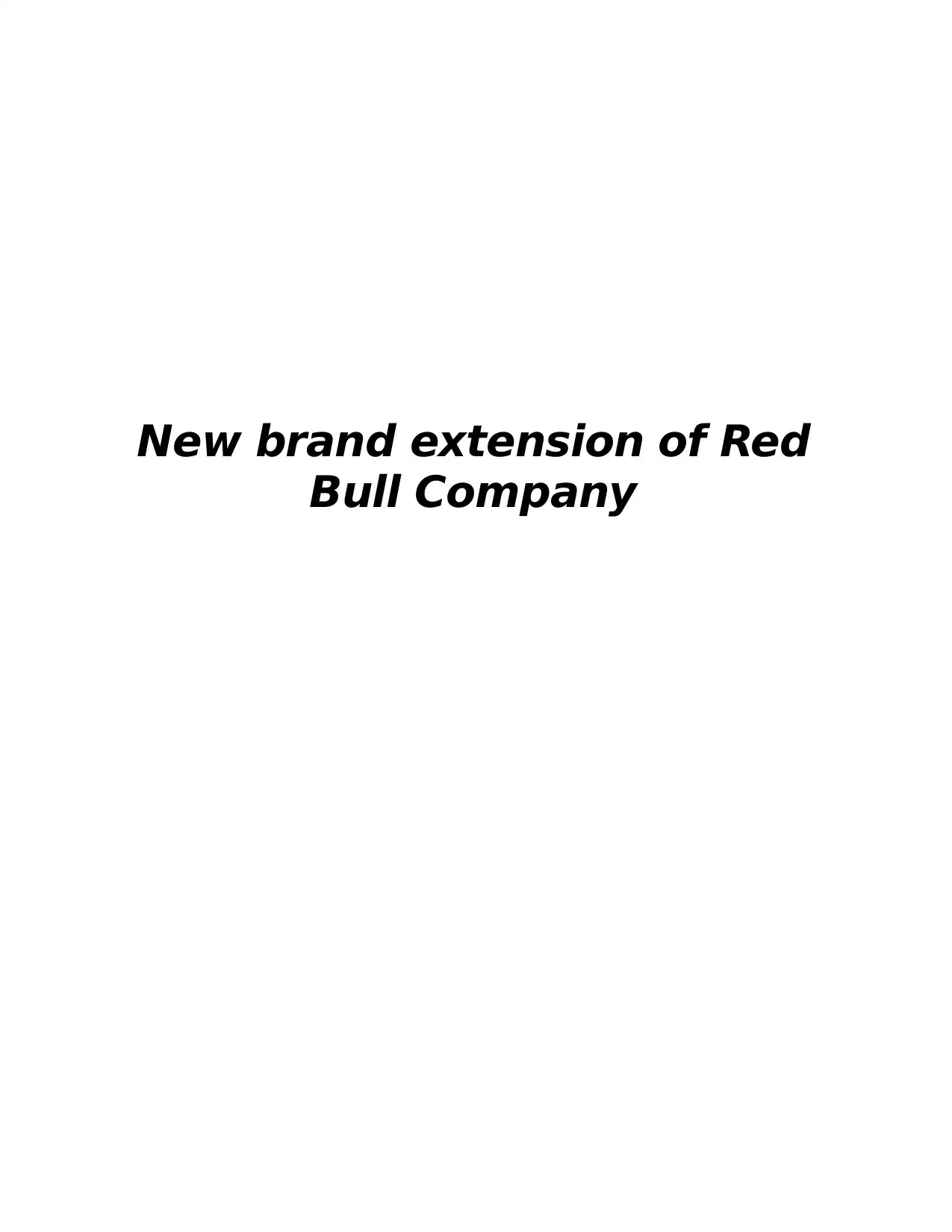
New brand extension of Red
Bull Company
Bull Company
Paraphrase This Document
Need a fresh take? Get an instant paraphrase of this document with our AI Paraphraser
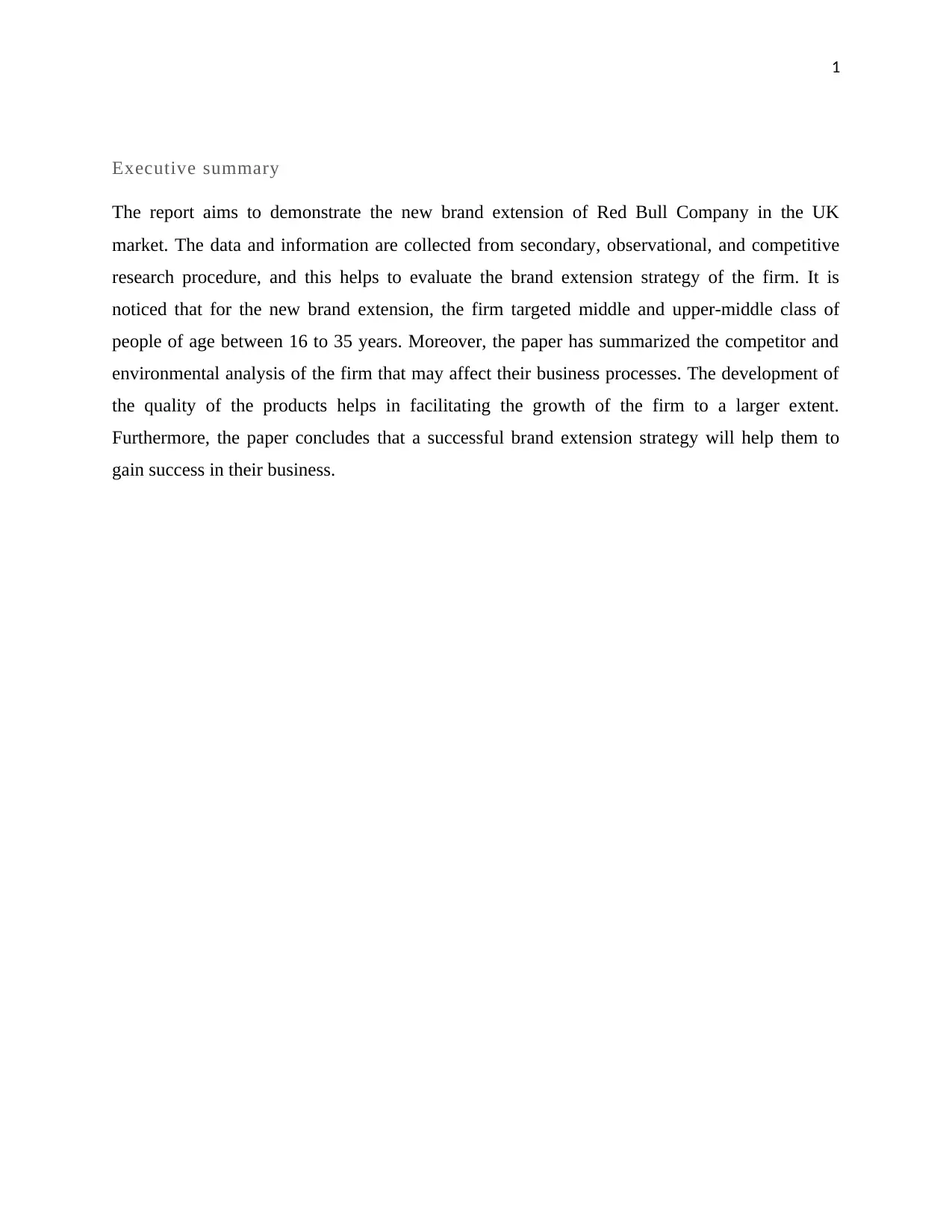
1
Executive summary
The report aims to demonstrate the new brand extension of Red Bull Company in the UK
market. The data and information are collected from secondary, observational, and competitive
research procedure, and this helps to evaluate the brand extension strategy of the firm. It is
noticed that for the new brand extension, the firm targeted middle and upper-middle class of
people of age between 16 to 35 years. Moreover, the paper has summarized the competitor and
environmental analysis of the firm that may affect their business processes. The development of
the quality of the products helps in facilitating the growth of the firm to a larger extent.
Furthermore, the paper concludes that a successful brand extension strategy will help them to
gain success in their business.
Executive summary
The report aims to demonstrate the new brand extension of Red Bull Company in the UK
market. The data and information are collected from secondary, observational, and competitive
research procedure, and this helps to evaluate the brand extension strategy of the firm. It is
noticed that for the new brand extension, the firm targeted middle and upper-middle class of
people of age between 16 to 35 years. Moreover, the paper has summarized the competitor and
environmental analysis of the firm that may affect their business processes. The development of
the quality of the products helps in facilitating the growth of the firm to a larger extent.
Furthermore, the paper concludes that a successful brand extension strategy will help them to
gain success in their business.
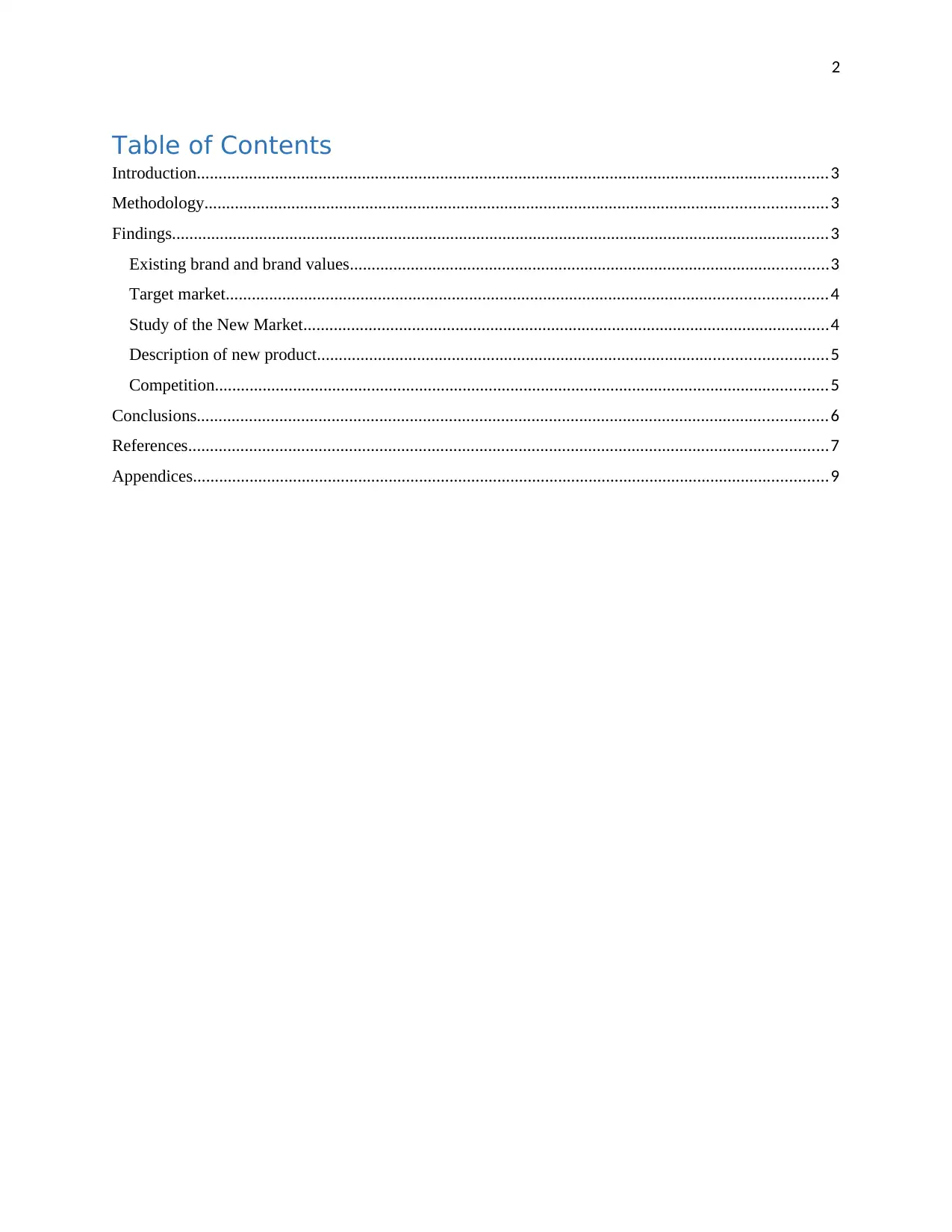
2
Table of Contents
Introduction.................................................................................................................................................3
Methodology...............................................................................................................................................3
Findings.......................................................................................................................................................3
Existing brand and brand values..............................................................................................................3
Target market..........................................................................................................................................4
Study of the New Market.........................................................................................................................4
Description of new product.....................................................................................................................5
Competition.............................................................................................................................................5
Conclusions.................................................................................................................................................6
References...................................................................................................................................................7
Appendices..................................................................................................................................................9
Table of Contents
Introduction.................................................................................................................................................3
Methodology...............................................................................................................................................3
Findings.......................................................................................................................................................3
Existing brand and brand values..............................................................................................................3
Target market..........................................................................................................................................4
Study of the New Market.........................................................................................................................4
Description of new product.....................................................................................................................5
Competition.............................................................................................................................................5
Conclusions.................................................................................................................................................6
References...................................................................................................................................................7
Appendices..................................................................................................................................................9
⊘ This is a preview!⊘
Do you want full access?
Subscribe today to unlock all pages.

Trusted by 1+ million students worldwide
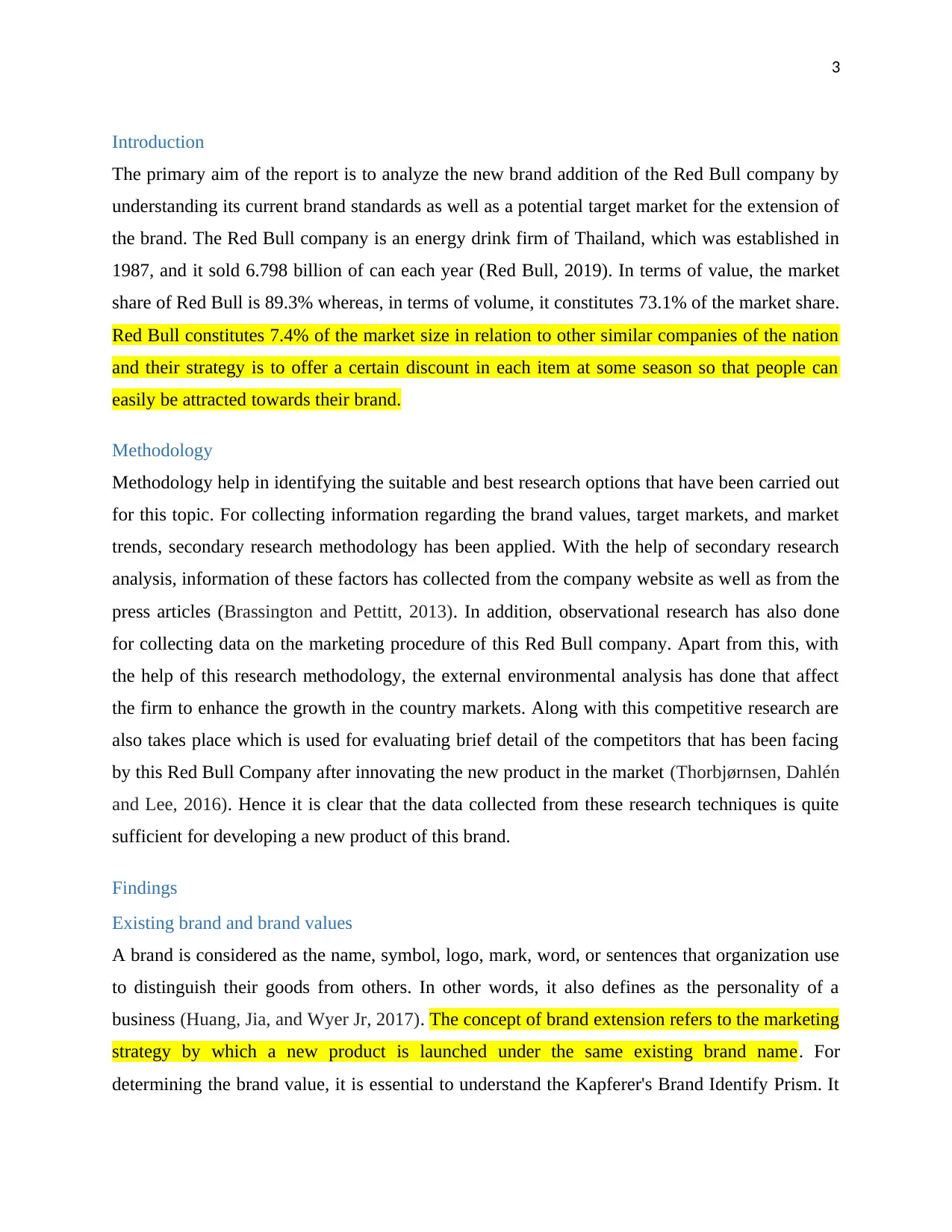
3
Introduction
The primary aim of the report is to analyze the new brand addition of the Red Bull company by
understanding its current brand standards as well as a potential target market for the extension of
the brand. The Red Bull company is an energy drink firm of Thailand, which was established in
1987, and it sold 6.798 billion of can each year (Red Bull, 2019). In terms of value, the market
share of Red Bull is 89.3% whereas, in terms of volume, it constitutes 73.1% of the market share.
Red Bull constitutes 7.4% of the market size in relation to other similar companies of the nation
and their strategy is to offer a certain discount in each item at some season so that people can
easily be attracted towards their brand.
Methodology
Methodology help in identifying the suitable and best research options that have been carried out
for this topic. For collecting information regarding the brand values, target markets, and market
trends, secondary research methodology has been applied. With the help of secondary research
analysis, information of these factors has collected from the company website as well as from the
press articles (Brassington and Pettitt, 2013). In addition, observational research has also done
for collecting data on the marketing procedure of this Red Bull company. Apart from this, with
the help of this research methodology, the external environmental analysis has done that affect
the firm to enhance the growth in the country markets. Along with this competitive research are
also takes place which is used for evaluating brief detail of the competitors that has been facing
by this Red Bull Company after innovating the new product in the market (Thorbjørnsen, Dahlén
and Lee, 2016). Hence it is clear that the data collected from these research techniques is quite
sufficient for developing a new product of this brand.
Findings
Existing brand and brand values
A brand is considered as the name, symbol, logo, mark, word, or sentences that organization use
to distinguish their goods from others. In other words, it also defines as the personality of a
business (Huang, Jia, and Wyer Jr, 2017). The concept of brand extension refers to the marketing
strategy by which a new product is launched under the same existing brand name. For
determining the brand value, it is essential to understand the Kapferer's Brand Identify Prism. It
Introduction
The primary aim of the report is to analyze the new brand addition of the Red Bull company by
understanding its current brand standards as well as a potential target market for the extension of
the brand. The Red Bull company is an energy drink firm of Thailand, which was established in
1987, and it sold 6.798 billion of can each year (Red Bull, 2019). In terms of value, the market
share of Red Bull is 89.3% whereas, in terms of volume, it constitutes 73.1% of the market share.
Red Bull constitutes 7.4% of the market size in relation to other similar companies of the nation
and their strategy is to offer a certain discount in each item at some season so that people can
easily be attracted towards their brand.
Methodology
Methodology help in identifying the suitable and best research options that have been carried out
for this topic. For collecting information regarding the brand values, target markets, and market
trends, secondary research methodology has been applied. With the help of secondary research
analysis, information of these factors has collected from the company website as well as from the
press articles (Brassington and Pettitt, 2013). In addition, observational research has also done
for collecting data on the marketing procedure of this Red Bull company. Apart from this, with
the help of this research methodology, the external environmental analysis has done that affect
the firm to enhance the growth in the country markets. Along with this competitive research are
also takes place which is used for evaluating brief detail of the competitors that has been facing
by this Red Bull Company after innovating the new product in the market (Thorbjørnsen, Dahlén
and Lee, 2016). Hence it is clear that the data collected from these research techniques is quite
sufficient for developing a new product of this brand.
Findings
Existing brand and brand values
A brand is considered as the name, symbol, logo, mark, word, or sentences that organization use
to distinguish their goods from others. In other words, it also defines as the personality of a
business (Huang, Jia, and Wyer Jr, 2017). The concept of brand extension refers to the marketing
strategy by which a new product is launched under the same existing brand name. For
determining the brand value, it is essential to understand the Kapferer's Brand Identify Prism. It
Paraphrase This Document
Need a fresh take? Get an instant paraphrase of this document with our AI Paraphraser
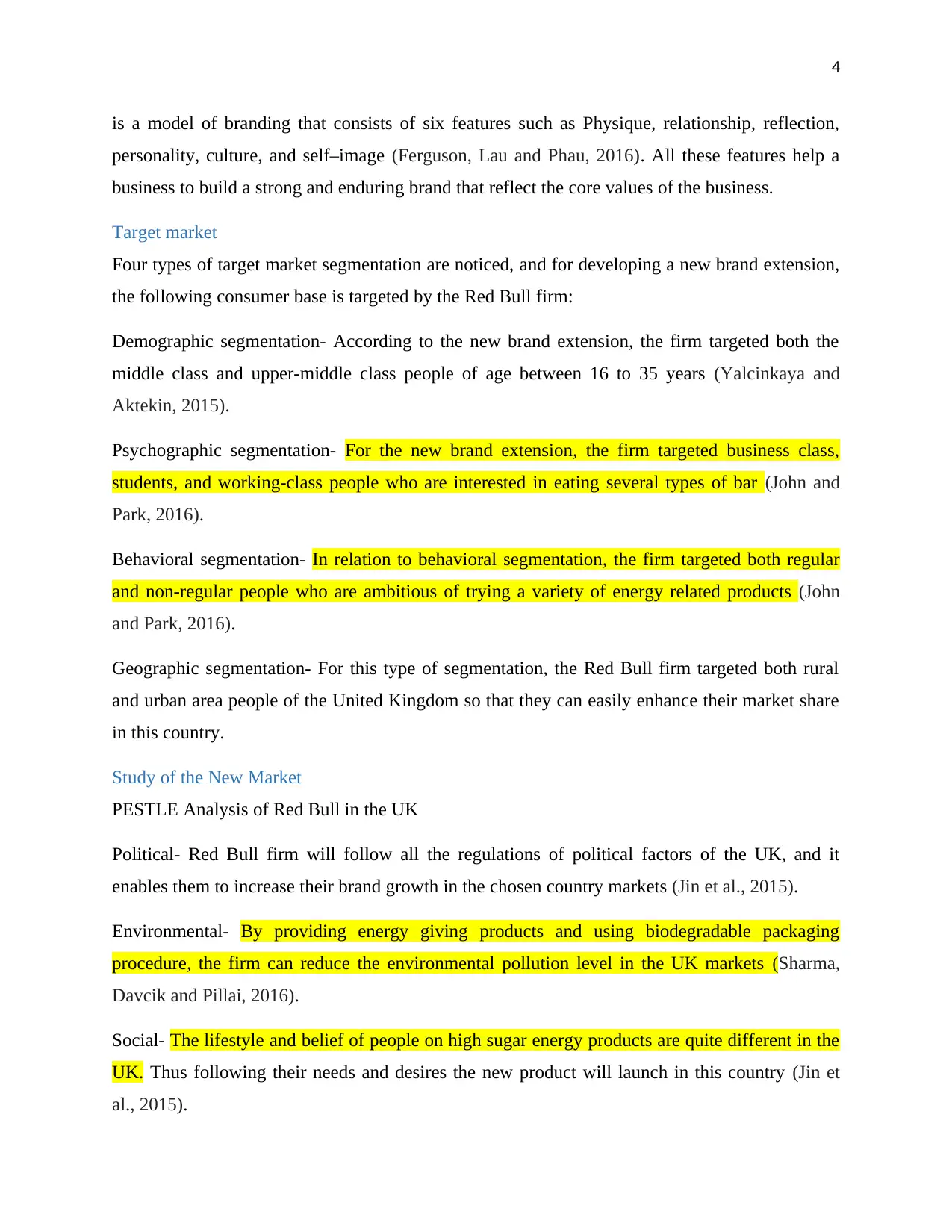
4
is a model of branding that consists of six features such as Physique, relationship, reflection,
personality, culture, and self–image (Ferguson, Lau and Phau, 2016). All these features help a
business to build a strong and enduring brand that reflect the core values of the business.
Target market
Four types of target market segmentation are noticed, and for developing a new brand extension,
the following consumer base is targeted by the Red Bull firm:
Demographic segmentation- According to the new brand extension, the firm targeted both the
middle class and upper-middle class people of age between 16 to 35 years (Yalcinkaya and
Aktekin, 2015).
Psychographic segmentation- For the new brand extension, the firm targeted business class,
students, and working-class people who are interested in eating several types of bar (John and
Park, 2016).
Behavioral segmentation- In relation to behavioral segmentation, the firm targeted both regular
and non-regular people who are ambitious of trying a variety of energy related products (John
and Park, 2016).
Geographic segmentation- For this type of segmentation, the Red Bull firm targeted both rural
and urban area people of the United Kingdom so that they can easily enhance their market share
in this country.
Study of the New Market
PESTLE Analysis of Red Bull in the UK
Political- Red Bull firm will follow all the regulations of political factors of the UK, and it
enables them to increase their brand growth in the chosen country markets (Jin et al., 2015).
Environmental- By providing energy giving products and using biodegradable packaging
procedure, the firm can reduce the environmental pollution level in the UK markets (Sharma,
Davcik and Pillai, 2016).
Social- The lifestyle and belief of people on high sugar energy products are quite different in the
UK. Thus following their needs and desires the new product will launch in this country (Jin et
al., 2015).
is a model of branding that consists of six features such as Physique, relationship, reflection,
personality, culture, and self–image (Ferguson, Lau and Phau, 2016). All these features help a
business to build a strong and enduring brand that reflect the core values of the business.
Target market
Four types of target market segmentation are noticed, and for developing a new brand extension,
the following consumer base is targeted by the Red Bull firm:
Demographic segmentation- According to the new brand extension, the firm targeted both the
middle class and upper-middle class people of age between 16 to 35 years (Yalcinkaya and
Aktekin, 2015).
Psychographic segmentation- For the new brand extension, the firm targeted business class,
students, and working-class people who are interested in eating several types of bar (John and
Park, 2016).
Behavioral segmentation- In relation to behavioral segmentation, the firm targeted both regular
and non-regular people who are ambitious of trying a variety of energy related products (John
and Park, 2016).
Geographic segmentation- For this type of segmentation, the Red Bull firm targeted both rural
and urban area people of the United Kingdom so that they can easily enhance their market share
in this country.
Study of the New Market
PESTLE Analysis of Red Bull in the UK
Political- Red Bull firm will follow all the regulations of political factors of the UK, and it
enables them to increase their brand growth in the chosen country markets (Jin et al., 2015).
Environmental- By providing energy giving products and using biodegradable packaging
procedure, the firm can reduce the environmental pollution level in the UK markets (Sharma,
Davcik and Pillai, 2016).
Social- The lifestyle and belief of people on high sugar energy products are quite different in the
UK. Thus following their needs and desires the new product will launch in this country (Jin et
al., 2015).
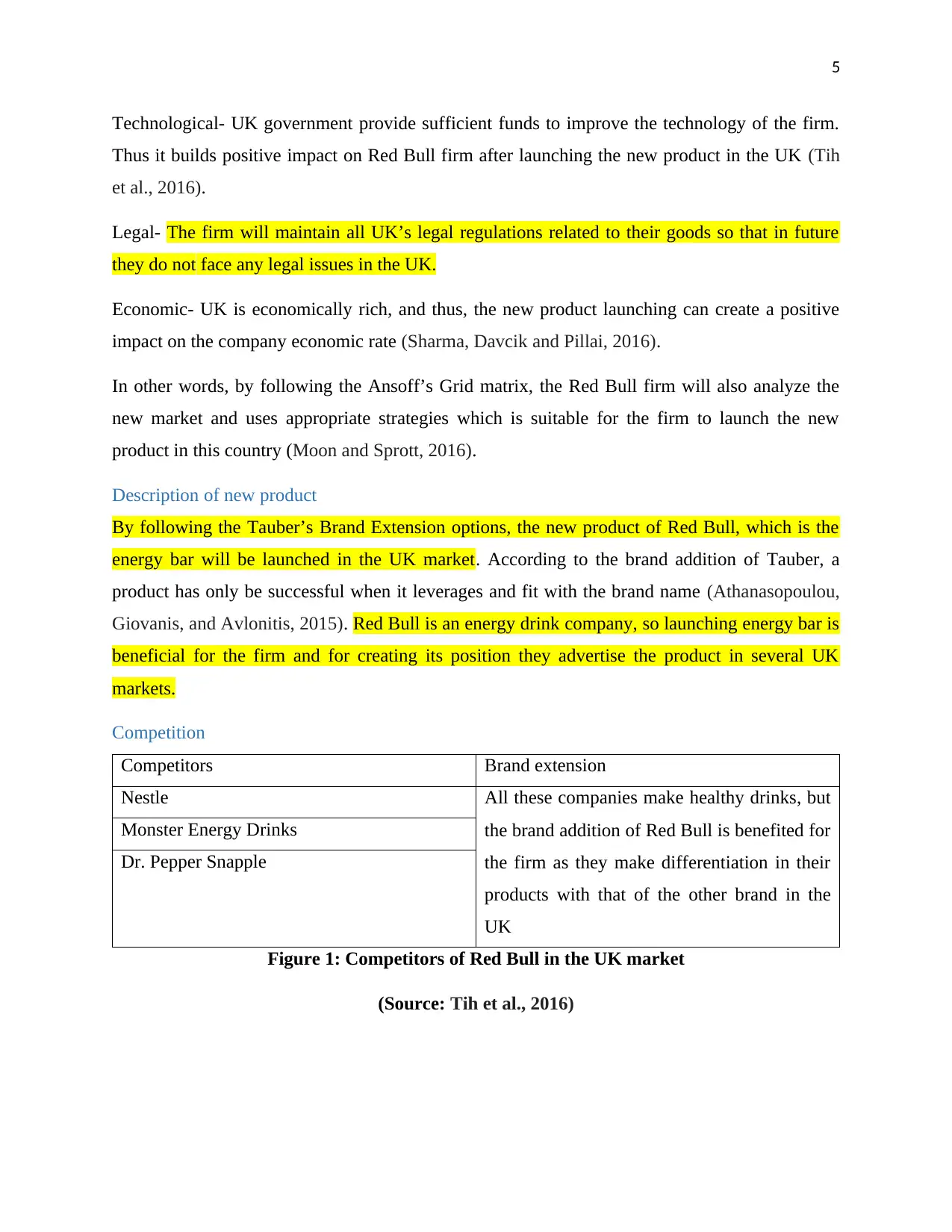
5
Technological- UK government provide sufficient funds to improve the technology of the firm.
Thus it builds positive impact on Red Bull firm after launching the new product in the UK (Tih
et al., 2016).
Legal- The firm will maintain all UK’s legal regulations related to their goods so that in future
they do not face any legal issues in the UK.
Economic- UK is economically rich, and thus, the new product launching can create a positive
impact on the company economic rate (Sharma, Davcik and Pillai, 2016).
In other words, by following the Ansoff’s Grid matrix, the Red Bull firm will also analyze the
new market and uses appropriate strategies which is suitable for the firm to launch the new
product in this country (Moon and Sprott, 2016).
Description of new product
By following the Tauber’s Brand Extension options, the new product of Red Bull, which is the
energy bar will be launched in the UK market. According to the brand addition of Tauber, a
product has only be successful when it leverages and fit with the brand name (Athanasopoulou,
Giovanis, and Avlonitis, 2015). Red Bull is an energy drink company, so launching energy bar is
beneficial for the firm and for creating its position they advertise the product in several UK
markets.
Competition
Competitors Brand extension
Nestle All these companies make healthy drinks, but
the brand addition of Red Bull is benefited for
the firm as they make differentiation in their
products with that of the other brand in the
UK
Monster Energy Drinks
Dr. Pepper Snapple
Figure 1: Competitors of Red Bull in the UK market
(Source: Tih et al., 2016)
Technological- UK government provide sufficient funds to improve the technology of the firm.
Thus it builds positive impact on Red Bull firm after launching the new product in the UK (Tih
et al., 2016).
Legal- The firm will maintain all UK’s legal regulations related to their goods so that in future
they do not face any legal issues in the UK.
Economic- UK is economically rich, and thus, the new product launching can create a positive
impact on the company economic rate (Sharma, Davcik and Pillai, 2016).
In other words, by following the Ansoff’s Grid matrix, the Red Bull firm will also analyze the
new market and uses appropriate strategies which is suitable for the firm to launch the new
product in this country (Moon and Sprott, 2016).
Description of new product
By following the Tauber’s Brand Extension options, the new product of Red Bull, which is the
energy bar will be launched in the UK market. According to the brand addition of Tauber, a
product has only be successful when it leverages and fit with the brand name (Athanasopoulou,
Giovanis, and Avlonitis, 2015). Red Bull is an energy drink company, so launching energy bar is
beneficial for the firm and for creating its position they advertise the product in several UK
markets.
Competition
Competitors Brand extension
Nestle All these companies make healthy drinks, but
the brand addition of Red Bull is benefited for
the firm as they make differentiation in their
products with that of the other brand in the
UK
Monster Energy Drinks
Dr. Pepper Snapple
Figure 1: Competitors of Red Bull in the UK market
(Source: Tih et al., 2016)
⊘ This is a preview!⊘
Do you want full access?
Subscribe today to unlock all pages.

Trusted by 1+ million students worldwide
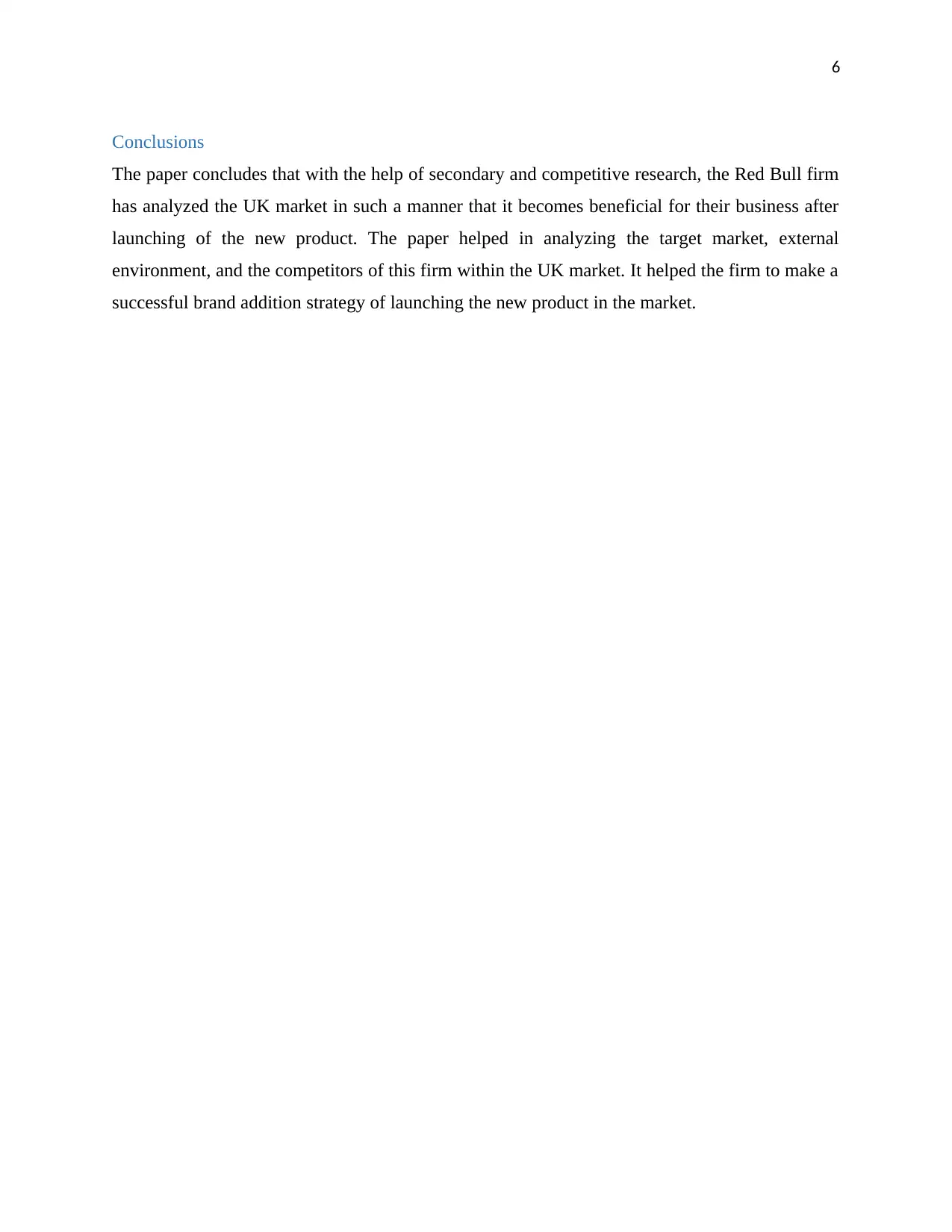
6
Conclusions
The paper concludes that with the help of secondary and competitive research, the Red Bull firm
has analyzed the UK market in such a manner that it becomes beneficial for their business after
launching of the new product. The paper helped in analyzing the target market, external
environment, and the competitors of this firm within the UK market. It helped the firm to make a
successful brand addition strategy of launching the new product in the market.
Conclusions
The paper concludes that with the help of secondary and competitive research, the Red Bull firm
has analyzed the UK market in such a manner that it becomes beneficial for their business after
launching of the new product. The paper helped in analyzing the target market, external
environment, and the competitors of this firm within the UK market. It helped the firm to make a
successful brand addition strategy of launching the new product in the market.
Paraphrase This Document
Need a fresh take? Get an instant paraphrase of this document with our AI Paraphraser
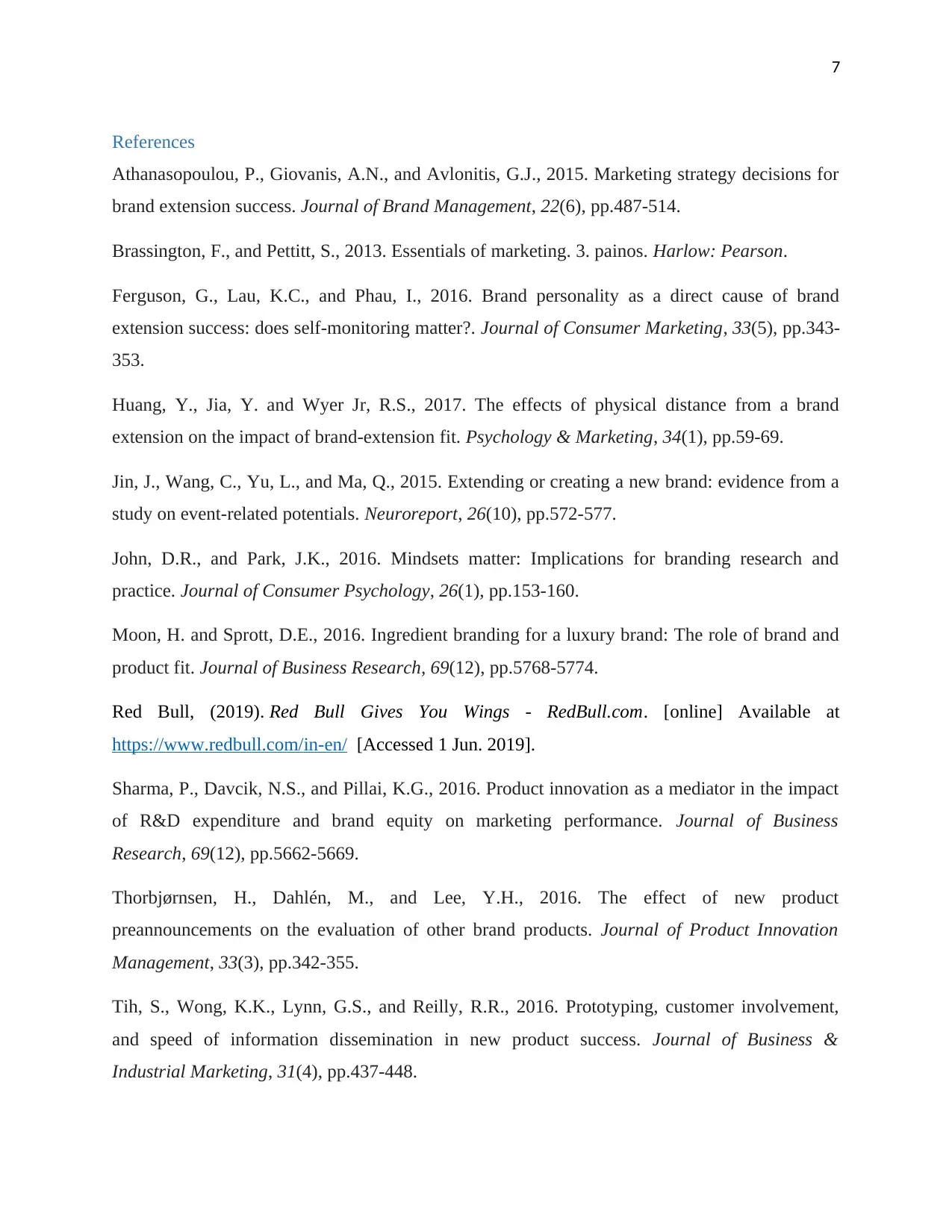
7
References
Athanasopoulou, P., Giovanis, A.N., and Avlonitis, G.J., 2015. Marketing strategy decisions for
brand extension success. Journal of Brand Management, 22(6), pp.487-514.
Brassington, F., and Pettitt, S., 2013. Essentials of marketing. 3. painos. Harlow: Pearson.
Ferguson, G., Lau, K.C., and Phau, I., 2016. Brand personality as a direct cause of brand
extension success: does self-monitoring matter?. Journal of Consumer Marketing, 33(5), pp.343-
353.
Huang, Y., Jia, Y. and Wyer Jr, R.S., 2017. The effects of physical distance from a brand
extension on the impact of brand‐extension fit. Psychology & Marketing, 34(1), pp.59-69.
Jin, J., Wang, C., Yu, L., and Ma, Q., 2015. Extending or creating a new brand: evidence from a
study on event-related potentials. Neuroreport, 26(10), pp.572-577.
John, D.R., and Park, J.K., 2016. Mindsets matter: Implications for branding research and
practice. Journal of Consumer Psychology, 26(1), pp.153-160.
Moon, H. and Sprott, D.E., 2016. Ingredient branding for a luxury brand: The role of brand and
product fit. Journal of Business Research, 69(12), pp.5768-5774.
Red Bull, (2019). Red Bull Gives You Wings - RedBull.com. [online] Available at
https://www.redbull.com/in-en/ [Accessed 1 Jun. 2019].
Sharma, P., Davcik, N.S., and Pillai, K.G., 2016. Product innovation as a mediator in the impact
of R&D expenditure and brand equity on marketing performance. Journal of Business
Research, 69(12), pp.5662-5669.
Thorbjørnsen, H., Dahlén, M., and Lee, Y.H., 2016. The effect of new product
preannouncements on the evaluation of other brand products. Journal of Product Innovation
Management, 33(3), pp.342-355.
Tih, S., Wong, K.K., Lynn, G.S., and Reilly, R.R., 2016. Prototyping, customer involvement,
and speed of information dissemination in new product success. Journal of Business &
Industrial Marketing, 31(4), pp.437-448.
References
Athanasopoulou, P., Giovanis, A.N., and Avlonitis, G.J., 2015. Marketing strategy decisions for
brand extension success. Journal of Brand Management, 22(6), pp.487-514.
Brassington, F., and Pettitt, S., 2013. Essentials of marketing. 3. painos. Harlow: Pearson.
Ferguson, G., Lau, K.C., and Phau, I., 2016. Brand personality as a direct cause of brand
extension success: does self-monitoring matter?. Journal of Consumer Marketing, 33(5), pp.343-
353.
Huang, Y., Jia, Y. and Wyer Jr, R.S., 2017. The effects of physical distance from a brand
extension on the impact of brand‐extension fit. Psychology & Marketing, 34(1), pp.59-69.
Jin, J., Wang, C., Yu, L., and Ma, Q., 2015. Extending or creating a new brand: evidence from a
study on event-related potentials. Neuroreport, 26(10), pp.572-577.
John, D.R., and Park, J.K., 2016. Mindsets matter: Implications for branding research and
practice. Journal of Consumer Psychology, 26(1), pp.153-160.
Moon, H. and Sprott, D.E., 2016. Ingredient branding for a luxury brand: The role of brand and
product fit. Journal of Business Research, 69(12), pp.5768-5774.
Red Bull, (2019). Red Bull Gives You Wings - RedBull.com. [online] Available at
https://www.redbull.com/in-en/ [Accessed 1 Jun. 2019].
Sharma, P., Davcik, N.S., and Pillai, K.G., 2016. Product innovation as a mediator in the impact
of R&D expenditure and brand equity on marketing performance. Journal of Business
Research, 69(12), pp.5662-5669.
Thorbjørnsen, H., Dahlén, M., and Lee, Y.H., 2016. The effect of new product
preannouncements on the evaluation of other brand products. Journal of Product Innovation
Management, 33(3), pp.342-355.
Tih, S., Wong, K.K., Lynn, G.S., and Reilly, R.R., 2016. Prototyping, customer involvement,
and speed of information dissemination in new product success. Journal of Business &
Industrial Marketing, 31(4), pp.437-448.
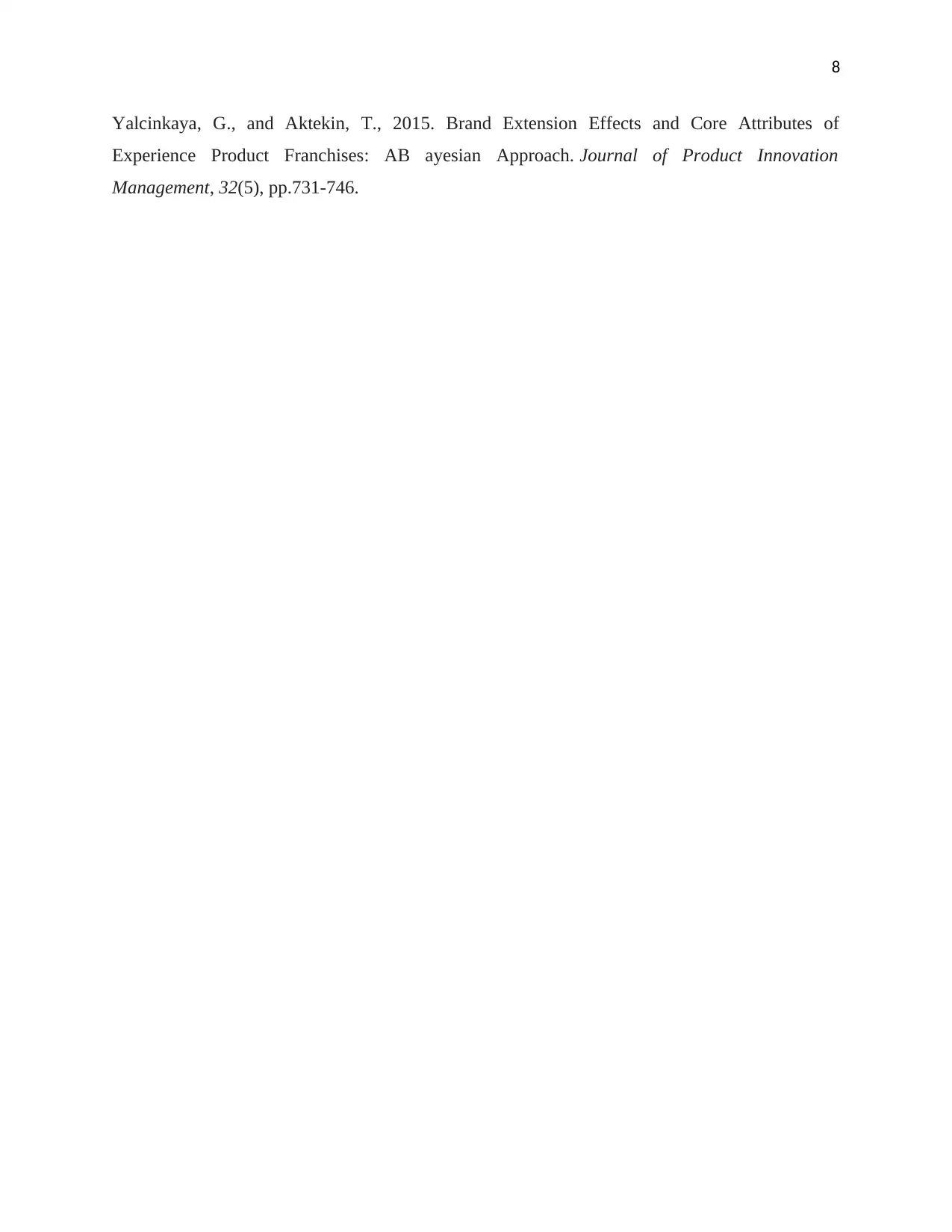
8
Yalcinkaya, G., and Aktekin, T., 2015. Brand Extension Effects and Core Attributes of
Experience Product Franchises: AB ayesian Approach. Journal of Product Innovation
Management, 32(5), pp.731-746.
Yalcinkaya, G., and Aktekin, T., 2015. Brand Extension Effects and Core Attributes of
Experience Product Franchises: AB ayesian Approach. Journal of Product Innovation
Management, 32(5), pp.731-746.
⊘ This is a preview!⊘
Do you want full access?
Subscribe today to unlock all pages.

Trusted by 1+ million students worldwide
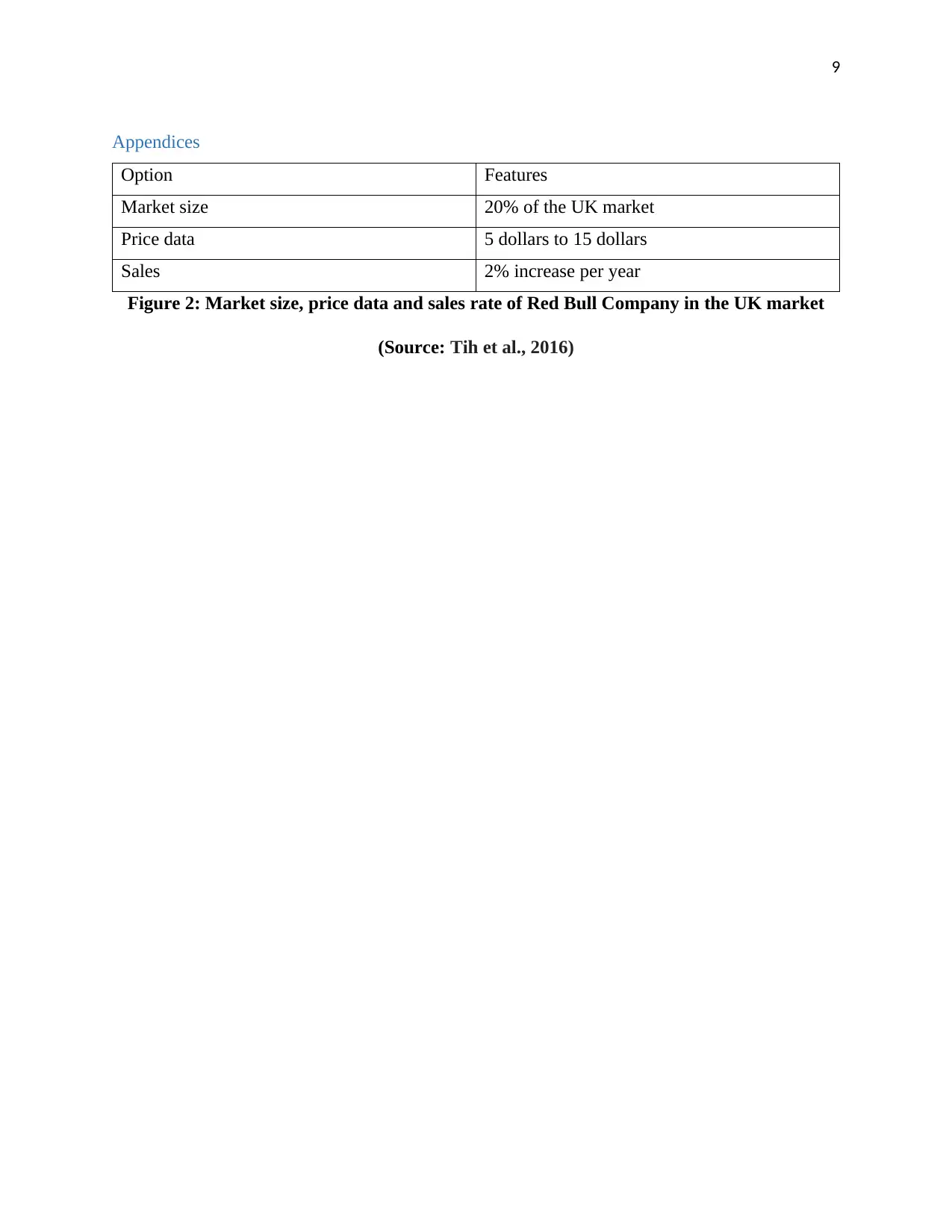
9
Appendices
Option Features
Market size 20% of the UK market
Price data 5 dollars to 15 dollars
Sales 2% increase per year
Figure 2: Market size, price data and sales rate of Red Bull Company in the UK market
(Source: Tih et al., 2016)
Appendices
Option Features
Market size 20% of the UK market
Price data 5 dollars to 15 dollars
Sales 2% increase per year
Figure 2: Market size, price data and sales rate of Red Bull Company in the UK market
(Source: Tih et al., 2016)
1 out of 10
Related Documents
Your All-in-One AI-Powered Toolkit for Academic Success.
+13062052269
info@desklib.com
Available 24*7 on WhatsApp / Email
![[object Object]](/_next/static/media/star-bottom.7253800d.svg)
Unlock your academic potential
Copyright © 2020–2025 A2Z Services. All Rights Reserved. Developed and managed by ZUCOL.




